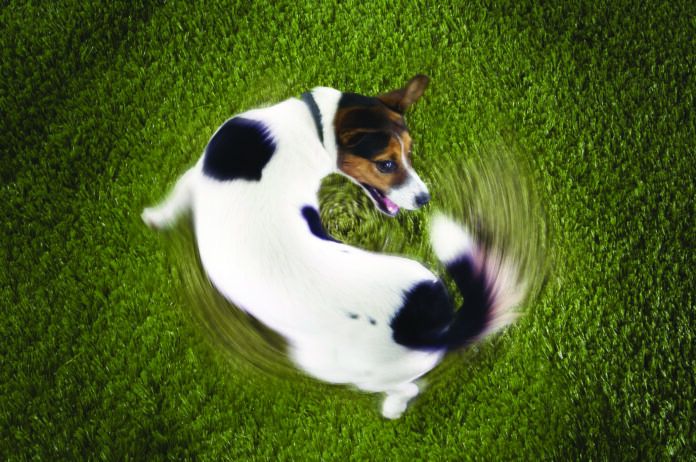Chasing his own tail to the point of sheer exhaustion, licking his ankles and feet until he strips off his skin, continuously snapping at imaginary flies, biting his own flank nonstop…these are among the compulsive behaviors that end up afflicting dogs. Such behaviors, equivalent to obsessive compulsive disorder in people, make the animals miserable, unable to enjoy a single moment of their lives and even interfering with their ability to take comfort from their human guardians.
There’s definitely a genetic component. Dobermans are the breed mostly likely to engage in flank sucking, while bull terriers are the most apt to chase their own tails. But lifestyle decidedly plays a role. Researchers in the Department of Veterinary Sciences at Finland’s University of Helsinki made the point in looking at information on more than 4,400 dogs, almost 30 percent of whom displayed repetitive behaviors. In so doing, they were able to put a lens on a number of specific lifestyle factors that could potentially impact the chance that a dog will develop what is known in veterinary circles as canine compulsive disorder.
First-time dog owner. A dog who is someone’s first canine pet is almost 60 percent more likely to have repetitive behavior than a dog who lives with a person or people who have had dogs before, the study shows. The researchers, reporting in Scientific Reports, suggest that perhaps first-time dog guardians are more apt to provide inconsistent training, which could lead to stress that paves the way for obsessive behaviors.
Large families. Dogs who live in homes with just one person are about a third less likely to develop canine compulsive disorder than dogs living with two or more people. Not all previous studies found this correlation, but if it holds up in future research, it may be that multi-people households come with more stress. Additionally, single people may devote more time to their dogs than people who live with others, and the lack of attention in a larger family could render a dog anxious enough to start doing himself harm.
Only dog in household. Only dogs are much more likely than dogs who live with others of their own kind to end up with compulsive repetition behaviors, perhaps because living “alone” increases their feelings of boredom and frustration.
Of course, you’re not going to change the size of your family to decrease your dog’s odds of developing canine compulsive disorder, and chances are also low that you’re going to bring home a second dog for that purpose. Nor can you “decide” not to be a first-time dog owner (although you can make a pact with your pet to train him consistently and give him plenty of “we” time). But the researchers did find one risk factor for damaging repetitive behaviors that is decidedly within your control — and which outdoes all the others in terms of
its impact.
Lack of adequate exercise. The investigators discovered that dogs getting less than an hour of exercise each day are at least 50 percent more likely to end up with repetitive behaviors as dogs who are physically active for 1 to 2 hours daily. They are almost twice as likely to have signs of canine compulsive disorder as dogs who engage in physical activity for 2 to 3 hours daily, and more than twice as likely as dogs who exercise for more than 3 hours a day, on average.
It’s not surprising. Dogs are not built for sitting on — or off — the couch all day. They are meant to live extremely active lives outdoors, with lots of running around — and often with a job to perform, such as herding or hunting.
With that in mind, do everything you can to keep your dog’s body and mind active for as much time as you can spare. Take him for walks, toss a ball for him, or enroll him in classes such as those for agility or flyball. If your dog enjoys the company of other dogs, you can send him to doggie daycare.
Imagine forcing a world-class athlete to sit alone in your house all day and watch television programs he didn’t understand or listen to music he didn’t find interesting. That’s what it’s like for a dog who doesn’t get enough stimulation. He becomes a kind of prisoner in your living room, waiting for that short period of time he’s allowed out of his “cell.” It’s not surprising that in that situation, he might start going after his own body.





